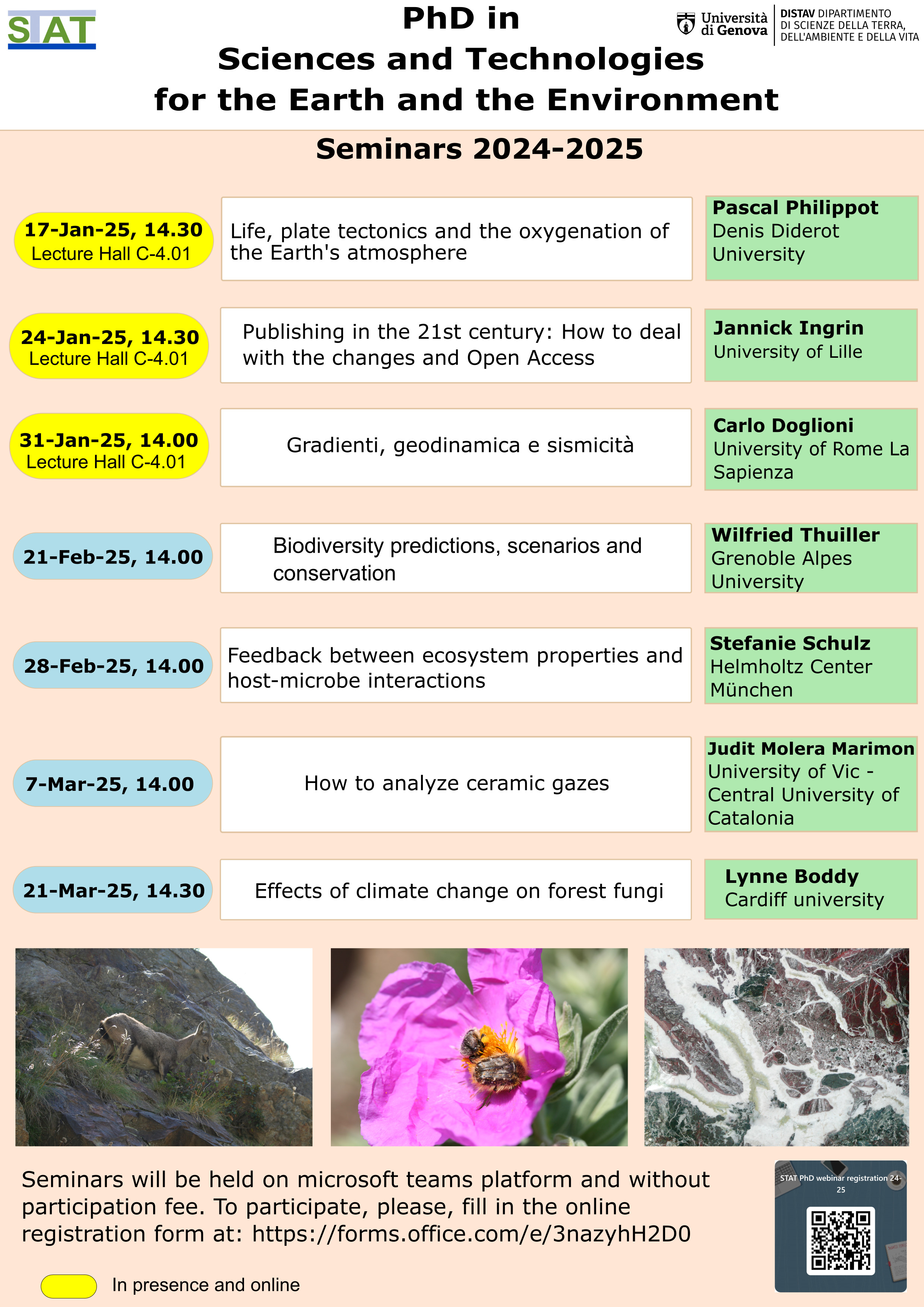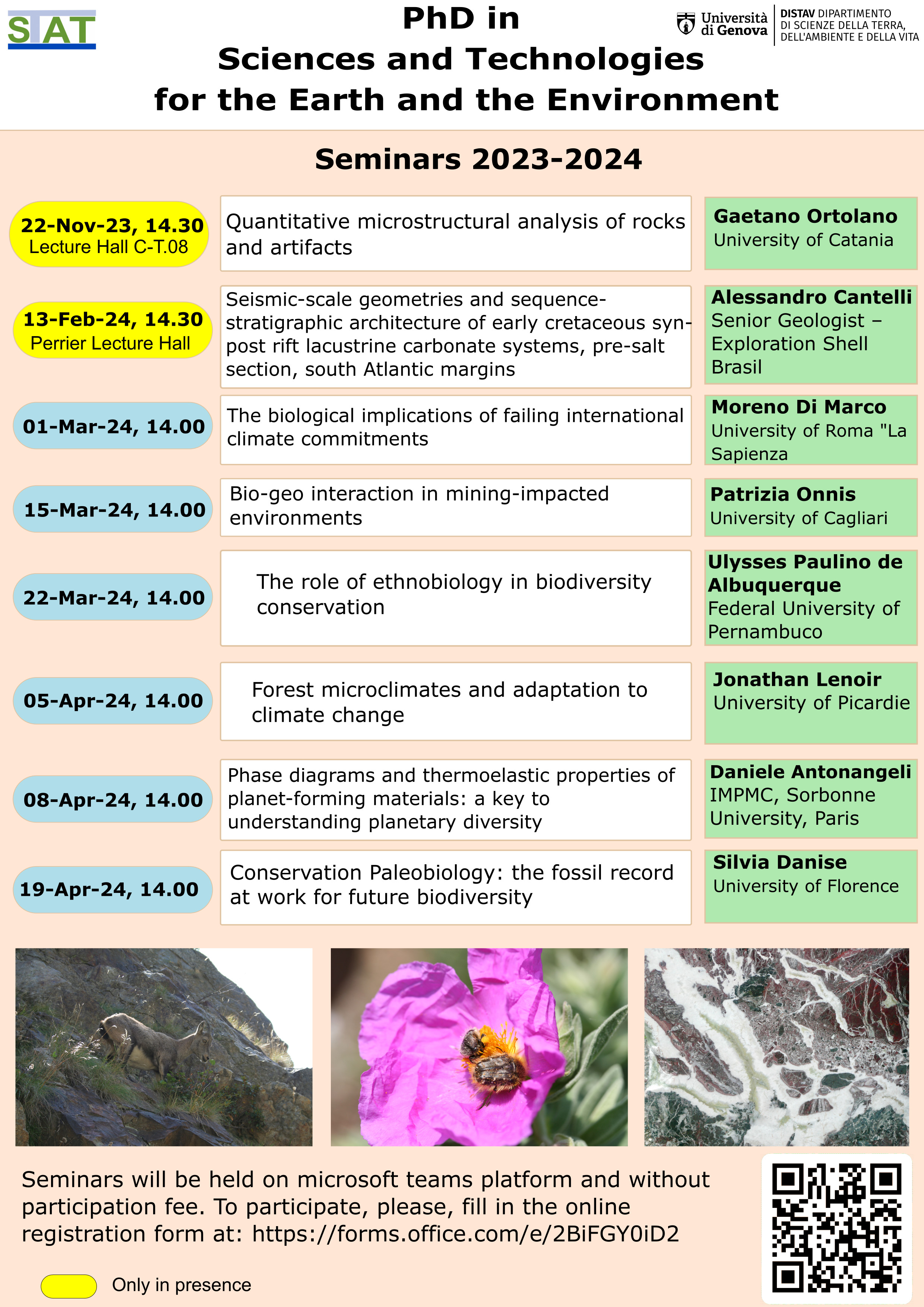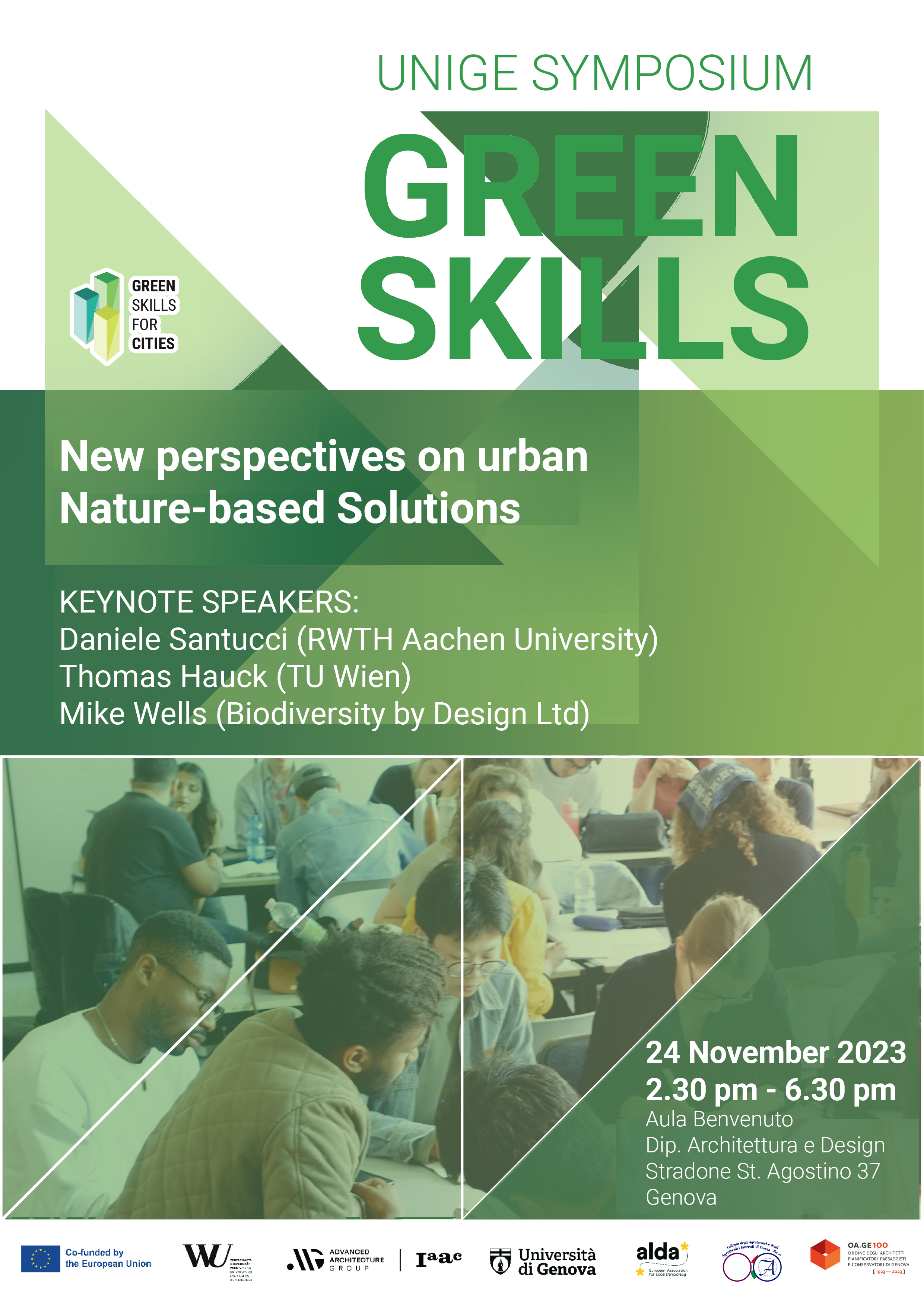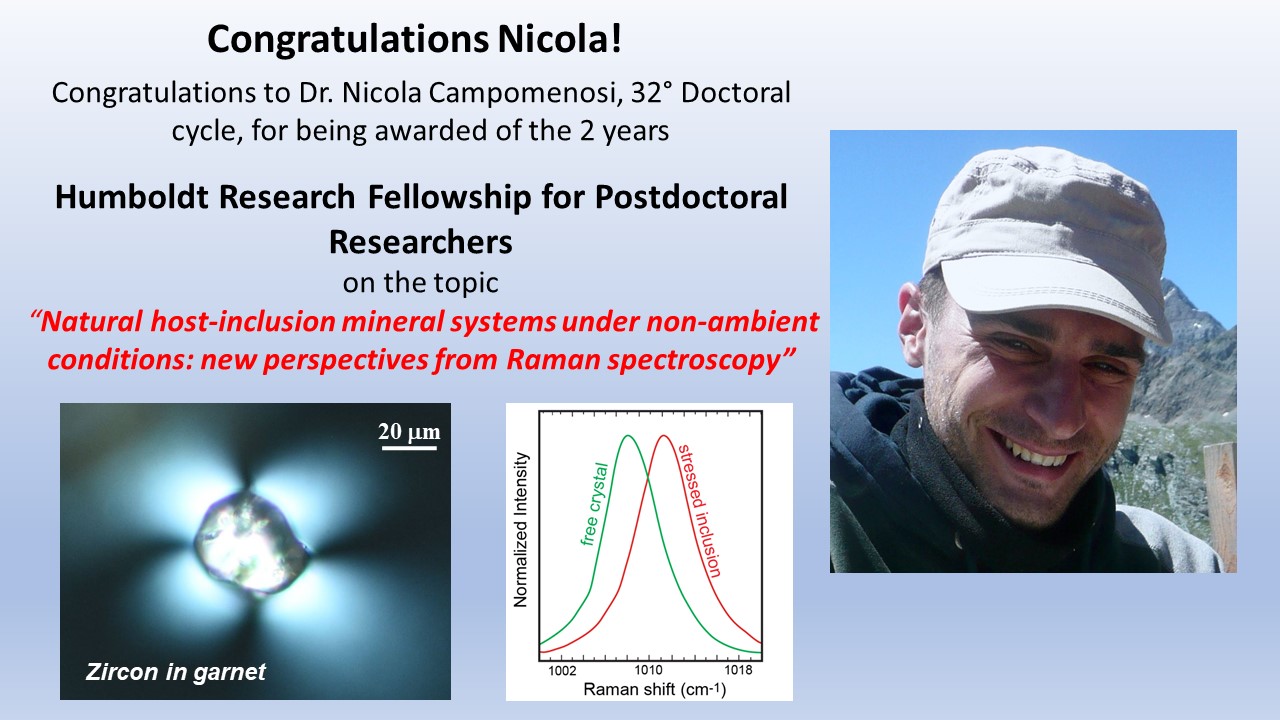Curriculum di Biologia Applicata all'Agricoltura e all'Ambiente (Cod. 10568)
Ulteriori informazioni alla pagina: https://distav.unige.it/phdstat/it/admission_2023
Tema di Ricerca N. 1 / Research Theme N. 1
Titolo
“Valutazione degli effetti e dei meccanismi molecolari coinvolti nell’azione citoprotettiva di molecole bioattive sul metabolismo e la struttura cellulare mediante utilizzo di modelli cellulari” (Borsa di Ateneo)
Title
“Evaluation of the effects and molecular mechanisms involved in the cytoprotective action of bioactive molecules on cell metabolism and structure using in in vitro models” (University grant)
Tutor
Prof. Laura Vergani, laura.vergani@unige.it
Co-tutors
Prof. Alberto Diaspro, alberto.diaspro@iit.it; Dr. Francesca Baldini, francesca.baldini@iit.it
Program description including the formation program abroad
The project aims to train qualified researchers in the field of molecular/cellular physiology focusing on the characterization of bioactive biological compounds and on the investigation of the mechanisms of their activity on cell function and structure. In particular, the biological effects will be investigated in terms of cell metabolism changes and remodeling of chromatin structure.
Among the bioactive compounds, a special interest will focus on phytochemicals and endogenous compounds for their possible application as dietary supplements, superfood and nutraceuticals.
Phytochemical analyses and biological and biophysical assays will be carried out with the support and collaboration of other Italian Universities and Research Institutions with whom our team has a long-standing and fruitful collaboration (University Aldo Moro of Bari; Istituto Italiano di Tecnologia – II and DIMES of University of Genova).
For the experimental activity the following techniques will be used: in vitro cell culture; molecular and cell biology techniques; Fluorescence (Confocal and STED) microscopy; Image analysis; Spectrophotometry and Fluorimetry; HPLC (high performance liquid chromatography), and GC-MS (gas chromatography-mass spectrometry).
Given the multidisciplinary approach of the research, periods of mobility are foreseen inside the collaboration with national Universities and Institutions. In addition, a period of 3-6 months in qualified foreign institutions may also be envisaged, to study specific topics related to the PhD project.
The research will be conducted in the frame of EU H2020 PRIMA (Partnership for Research and Innovation in the Mediterranean Area) Section 2, 2022 “Box for Health by Tradition & innovation: promoting sustainable Mediterranean diet by Healthy Foods (B4HT)” of which the proponent is PI of the winning Consortium.
Tema di Ricerca N. 2 / Research Theme N. 2
Titolo
"Come il buffering geologico e climatico ha modellato la diversità vegetale negli hotspot di biodiversità" (Borsa di Ateneo)
Title
"How geological and climatic buffering shaped plant diversity in hotspots of biodiversity" (University grant)
Tutor
Gabriele Casazza, gabriele.casazza@unige.it
Program description including the formation program abroad
Old, climatically buffered, and infertile landscapes (OCBILs) theory aims to elucidate the origins of high species richness and endemism on relatively subdued terrains. It also provides an explanatory framework to account for the extraordinary adaptations and life histories of sedentary organisms in these areas. Moreover, it also provides a conceptual framework for improving conservation efforts. In particular, OCBILs are expected to: (1) reduced dispersibility, increasing endemism and prevalent rarity; (2) favouring persistence of old lineages; (3) favouring heterozygosity; and (4) selecting for nutritional and other biological specialization. OCBILs are most abundant in the Southern Hemisphere where have been recently investigated. However, very few studies aimed at testing OCIBIL theory in North hemisphere. Consequently, much has to be learnt about the relevance and applicability of OCBIL theory to conserving biodiversity at global scale. For this reason, this project aims at testing OCBILs predictions in the Mediterranean Basin.
Tema di Ricerca N. 3 / Research Theme N. 3
Titolo
"Funghi come biodeteriogeni del legno" (Borsa di Ateneo)
Title
"Fungi as wood biodeteriogens" (University grant)
Tutor
Simone Di Piazza, simone.dipiazza@unige.it
Program description including the formation program abroad
Degradation, of complex molecules such as lignin and cellulose, is key trait of several fungi. Wood biodegradative activity is the basis of natural biogeochemical cycles fundamental for the health of the planet, particularly the carbon cycle. Everything changes when this activity takes place for example on artefacts or works of art. In such cases, due to the negative effects, the term used is biodeterioration. In-depth knowledge of lignicolous fungal species and mechanisms that generate biodeterioration is the basis for the protection of wooden cultural heritage.
The aim of the project is to implement the ColD-JRU Mirri collection with fungal strains isolated from contaminated and/or potentially contaminated woods or wooden objects. The isolated strains will be characterized by polyphasic approach and stored in ColD collection. Moreover, their biodeteriogenic activity will be evaluated on different wood species and in vitro test will be carried out to find new natural product to stop their proliferation. During the project, the candidate will spend a period of 6 month abroad within a framework of collaboration with international research group such as Westerdijk Fungal Biodiversity Institute (the Netherlands) and Institute for Natural Sciences and Technology in the Arts (Austria).
Tema di Ricerca N. 4 / Research Theme N. 4
Titolo
"Valutazione del rischio per le specie invasive con particolare attenzione ai processi competitivi con le specie autoctone" (Borsa di MUR/Dipartimento)
Title
"Risk assessment for invasive species with particular attention to competitive processes with native species" (MUR / DISTAV grant)
Tutor
Luigi Minuto, luigi.minuto@unige.it
Co-Tutor
Gabriele Casazza, gabriele.casazza@unige.it
Program description including the formation program abroad
The research program aims to assess the risk for invasive species in the Mediterranean area taking into account the competitive processes between invasive and native species. These processes will be assessed at different spatial and ecological scale. The PhD student must spend at least three months in a foreign institution.
Tema di Ricerca N. 5 / Research Theme N. 5
Titolo
"Aereomicologia: la valutazione dei requisiti della qualità dell’aria, tramite la determinazione della concentrazione di inquinanti microbiologici fungini" (Borsa finanziata su fondi del Dipartimento)
Title
"Aeromycology: evaluation of air quality requirements through determination of airborne fungal microbiological pollutant concentrations" (Department grant)
Tutor
Mirca Zotti, mirca.zotti@unige.it
Program description including the formation program abroad
Aeromycology is a branch of aerobiology that studies the presence of fungal spores in the air, both indoors and outdoors, and their potential implications for human and plant health, as well as the preservation of artifacts and food. Through a polybasic approach, the research will aim to evaluate the diversity of fungi in the samples collected and analyze some of their functional traits (such as xerotolerance, thermophily, PGPF), biodeterioration activity on materials, and pathogenicity. The samples may also be collected using specifically equipped drones.
During the project, the candidate will spend a period of 6 month abroad within a framework of collaboration with international research group such as Westerdijk Fungal Biodiversity Institute (Holland) and Institute for Natural Sciences and Technology in the Arts (Austria).
Tema di Ricerca N. 6 / Research Theme N. 6
Titolo
"I funghi come strumenti forensi" (Borsa HORIZON MSCA 2022-DN-01-01 Natural Traces)
Title
"Fungi as forensic tools" (HORIZON MSCA 2022-DN-01-01 -Natural Traces grant)
Tutor
Mirca Zotti, mirca.zotti@unige.it
Co-Tutor
Simone Di Piazza, simone.dipiazza@unige.it
Program description including the formation program abroad
Micro and macrofungi have great potential as forensic tool. In recent years, many of the applications of mycology went to forensic science. The project will improve basic biological mycological knowledge necessary for forensic interpretation. The aimed is to improve the knowledge of funga occurring on victims, belongings, and crime scenes. In this context, the focus will be on comparing the funga present in/on the victims with those present at the location where the corpse was discovered. To this goal, fungi will be studied by direct examination, cultured strain, isolation, long term preservations and DNA analysis. Moreover, the research will investigate the aging activity caused by growth of mycelia, through in vitro and in vivo experiment, exploiting the biodeterioration and biodegradation ability of fungi. The topics of the study are part of a Horizon 2020 MSCA called Natural Grace, which provides for training periods abroad among the various partners involved in the project.
Tema di Ricerca N. 7 / Research Theme N. 7
Titolo
"Valutazione della sicurezza in seguito all’accidentale inalazione di prodotti cosmetici" (riservato a personale di ANGEL Consulting S.a.s.)
Title
"Evaluation of Safety Following Accidental Inhalation of Cosmetic Products" (reserved for ANGEL Consulting S.a.s. employees)
Tutor
Elena Grasselli, elena.grasselli@unige.it
Co-Tutor
Matteo Zanotti Russo, info@angelconsulting.eu
Program description including the formation program abroad
The assessment of safety following accidental inhalation of cosmetic products is a crucial process to ensure the health and well-being of consumers. This type of incident can occur during the application of sprays, powders, or aerosols. It is essential to conduct thorough assessments to determine the potential respiratory health risks. Factors such as the chemical composition of the product, the amount inhaled, and the duration of exposure need to be taken into consideration.
Curriculum di Scienze della Terra (Cod. 10569)
Tema di Ricerca N. 1 / Research Theme N. 1
Titolo
“Individuazione e caratterizzazione di strutture legate a cicli sismici in rocce oceaniche esumate” (Borsa di Ateneo)
Title
“Finding and characterising the record of seismic cycles in exhumed oceanic rocks” (University grant)
Tutor
Laura Federico, laura.federico@unige.it
Co-tutor
Michele Locatelli, michele.locatelli@edu.unige.it
Program description including the formation program abroad
Within subduction complexes and orogenic belts, metamorphic oceanic units show a variety of geometries, ranging from near-continuous Km-scale bodies, with an original stratigraphy of the oceanic lithosphere still recognizable, to highly sliced and disrupted terrains where the oceanic lithologies have a poor lateral continuity (e.g.; mélanges and chaotic rock units). The processes and factors driving these variable arrangements may occur at different structural levels within, for example, the interface between the subducting and the upper plate, and they have yet to be clearly defined. Among the main factors we can include the presence and properties of syntectonic fluids, the rheological contrasts and mechanisms of mixing, the strain-rate and its partitioning, and the P-T-t of deformations.
Within these tectonic complexes, well-known structures related to seismic deformations have been described so far and their complex rheological behaviour makes them a privileged site where to explore the nucleation of slow-slip-events and tremors.
Tectonic mélanges and orogenic complexes with metamorphic oceanic remnants are therefore good candidates for the study of seismic cycles and transient, episodic ruptures at different structural levels.
The PhD candidate will address the above open questions applying a multiscale and inter- disciplinary approach, including detailed field mapping and 3D structural modeling of the study areas and integrated microstructural and petrological investigations (e.g.: SEM, EPMA, EBSD LA-ICP-MS, XCT scan).
Potential target areas for the field study are within the Italian Western Alps (e.g.; Voltri and Monviso massifs).
This research will be carried out in the framework of PRIN/MUR, CARG and PNRR projects that encompasse multidisciplinar research groups with expertise in either structural geology and minerochemical/petrology/geochemistry.
Collaboration and abroad experiences:
- Sorbonne Université, Institut des Sciences de la Terre de Paris
- Universität Bern, Institut für Geologie - Switzerland
- University of Washington, Department of Earth and Space Science
Tema di Ricerca N. 2 / Research Theme N. 2
Titolo
“Stratigrafia, facies e (bio)diversità dei depositi prossimali della trasgressione oligocenica in Liguria e Piemonte meridionale: Calibrazione biostratigrafica e ricostruzioni paleoambientali ad alta risoluzione" (Borsa di Ateneo)
Title
“Timing, facies and (bio)diversity of the shallow marine deposits of the Oligocene transgression in Liguria and southern Piedmont: coupling biostratigraphic data and high resolution palaeoenvironmental reconstructions” (University grant)
Tutor
Antonino Briguglio, antonino.briguglio@unige.it
Co-tutors
Michele Piazza, michele.piazza@unige.it; Andrea Baucon, andrea.baucon@unige.it
Program description including the formation program abroad
The Oligocene sedimentary deposits cropping out in Liguria and southern Piedmont are often characterized by continental to riverine to shallow marine facies and record a transgression event that moved westward from its oldest deposits north of Genova, to its end near Cuneo. They are lithologically very diverse and encompass from poorly sorted conglomerates to carbonate biohermes/biostromes. These latter can be at time rich in larger foraminifera, calcareous algae, cnidarians, and ichnofossils with different degrees of preservations. Whilst cnidarians, ichnofossils and red calcareous algae are important facies fossil, larger foraminifera have also a strong biostratigraphic potential. This project aims to use larger foraminifera as index fossils to create a chronostratigraphic map that reconstructs the dynamic of the shallow marine deposits in Liguria and southern Piedmont. The project will also use ichnofossils, abundant in the study area: they can help the reconstruction of precise palaeogeographic and palaeoenvironmental dataset.
Since all deposits are limited within the Oligocene and might reach the base of the Miocene, the use of Sr stable isotopes to constrain the geochronology of the sites might be a valuable option. For this reason, abroad mobility will be important at various institutions (Univ. Lausanne, Copenhagen Nat.Hist. Museum, Univ. Bonn) where the applicant can get deep insights into various laboratory techniques regarding geochemistry, applied biostratigraphy and precise palaeogeographic datasets.
Tema di Ricerca N. 3 / Research Theme N. 3
Titolo
“Monitoraggio multi-parametrico del processo sismogenetico: definizione di precursori sismici e loro applicazione nell’ambito della previsione dei terremoti" (Borsa di Ateneo)
Title
“Multi-parametric monitoring of the seismogenic process: definition of seismic precursors and their application in the field of earthquake forecasting” (University grant)
Tutors
Prof. Simone Barani, simone.barani@unige.it; Dr.Marco Massa, marco.massa@ingv.it
Co-tutor
Prof Gabriele Ferretti, gabriele.ferretti@unige.it
Program description including the formation program abroad
Earthquake prediction still represents one of the most ambitious challenges for the scientific community. Although there is still no way to predict a major earthquake, observational methods (e.g. near-fault observatories, multi-parametric monitoring) and mathematical techniques (e.g. multi- hazard analysis, machine learning) are constantly evolving in order to break the barrier that separates man from earthquake prediction. In this context, multi-parametric approaches allow a better understanding of complex, non-stationary systems, such as the seismic process. Thus, at least in principle, they are potentially more effective than approaches based on the analysis of single parameters in providing earthquake forecasts or warnings, which can be useful to public organizations within the framework of operational decision-making. Recently, the National Institute of Geophysics and Volcanology (INGV) released MUDA (geophysical and geochemical MUltiparametric Database), a new infrastructure for the dissemination of geophysical and geochemical data acquired in real time. The objective of this infrastructure is to allow scientists to study correlations between seismic events and variations in environmental parameters (e.g. level and conductivity of groundwater; flow of carbon dioxide), some of which are also of paramount importance in relation to climate change. The present proposal fits into this field of research. On the one hand, it aims at investigating the predictive power of environmental parameters (interpreted as earthquake precursors), possibly including proxies of different nature (e.g. deformation from GNSS and InSAR monitoring). On the other hand, it aims at developing new techniques for earthquake forecasting (or earthquake warning) that incorporate the information associated with multi-parametric data. To this end, the use of modern machine learning algorithms might prove invaluable. The final goal is to obtain a tool that can guide operational decision-making processes for seismic risk mitigation purposes.
Activities within the framework of the program will be mainly carried out at DISTAV – Università degli Studi di Genova with the support of INGV and Università degli Studi di Milano Bicocca (prof. Andrea Luca Rizzo). A 3-month period abroad at a European research organization is envisaged (e.g., University of Clermont-Auvergne).
Tema di Ricerca N. 4 / Research Theme N. 4
Titolo
“Svelare l'interno della Terra: utilizzare ampi insiemi di dati sismici per l'analisi" (Borsa di Ateneo)
Title
“Unraveling Earth's interior: harnessing extensive seismic data sets for analysis” (University grant)
Tutor
Daniele Spallarossa, daniele.spallarossa@unige.it
Co-tutor
Carla Barnaba, cbarnaba@ogs.it
Program description including the formation program abroad
The analysis of seismic data has always played a fundamental role in the study and understanding of seismic phenomena on Earth. In the last decade, significant advances in recording and analysis techniques have made it possible to create huge data sets of seismic data. In this context, the data collected during the seismic crises in Turkey (2023) and central Italy (2016-2017) are a source of invaluable information. Indeed, recent studies have shown that microseismicity analysis can be effectively used not only to study local and regional phenomena that modify the characteristics of seismic motion, but also to identify the preparatory phase of major seismic events. However, one of the main challenges is to identify the best features of seismic data sets and the most promising analysis techniques to effectively detect and characterize spatio-temporal variations in source or site parameters.
The candidate will address these open questions using different seismic data sets represented, for example, by extended seismic catalogs or specific features extracted from seismic signals.
The main objective of the project is to identify spatial and temporal variations of seismic features (such as ground motion anomalies, site effects, etc.) that can be correlated with the physical properties of the Earth's interior (e.g. attenuation, stress conditions, seismic wave velocities, etc.). In order to achieve the defined goals, traditional analysis techniques will be complemented by machine learning techniques, which are particularly suitable for dealing with very large data sets.
This research will be carried out within the PRIN/MUR and PNRR projects, involving multidisciplinary research groups with expertise in both observational seismology and seismic hazard analysis.
The PhD student will have the opportunity to develop the research program within the existing collaboration with OGS (Istituto Nazionale di Oceanografia e di Geofisica Sperimentale, Trieste, Italy), GFZ German Research Centre for Geosciences (Potsdam, Germany) and INGV (Istituto Nazionale di Geofisica e Vulcanologia, Milan, Italy).
Tema di Ricerca N. 5 / Research Theme N. 5
Titolo
“Modellizzazione geochimica della miscelazione di acque sotterranee con acque reflue in falde acquifere costiere" (borsa cofinanziata MUR/Dipartimento)
Title
“Geochemical modelling of groundwater mixing with wastewater in coastal aquifers” (co-funded MUR/Department grant)
Tutor
Marino Vetuschi Zuccolini, marino.zuccolini@unige.it
Program description including the formation program abroad
One of the top concerns of the circular economy regarding environmental protection is managing the pressures that arise from long periods of drought and high exploitation of water resources stored in groundwater. The direct effect of water table lowering for periods longer than the water supply emergency period pushes regulators to implement alternative solutions such as recycling wastewater in aquifers. To effectively solve a problem, a holistic and robust thermodynamic analysis is required to detect, measure, and forecast the complex schema of physical processes generated in reservoirs during and after re-injection.
The mixing of natural water and treated wastewater, both on the surface through spreading supply or directly in reservoir through well injection, can cause local changes by porosity alteration or degrading the quality of the entire groundwater body.
Potentially hazardous elements can be released or adsorbed (or exchanged) by bio-geochemical changes that overlap with a feedback effect, which is caused by physical or chemical changes due by changes in CO2 content in groundwater. In addition to this remarkable result related to water mixing, a natural barrier for the entrance of sea water in aquifers can be created by re-injection of pre-treated water, through a water recharge program.
The candidate will carry out an intensive field activity, followed by an analysis supported by significant computational effort to feature the geochemical behavior of the water reservoir of interest.
Assessment of the geochemical characteristics of water (main chemistry, stable isotopes, pharmaceutical metabolites, PHAS or nano-plastics) will be the starting point for the definition of the "ground-zero” state of the aquifer, previous whichever Managed Aquifer Recharge (MAR) solution.
A sampling period dedicated to spring and wells maintained by the institutional manager, will be developed to evaluate seasonal dynamic parameters used in the final phase.
Reconstructing a digital and high resolution, stochastically based 3D model of aquifer geological heterogeneities is the focus of the final step.
The main result will be a set of flow, transport, and reaction models that will evaluate geomechanical concerns, derived from a set of equivalent scenarios. The spatial and seasonal variability of the water system should be identified through a set of parameters provided by this approach. Based on these results, local, commercial, and political entities will be able to establish a general framework of solutions and regulations to test and monitor suggested solutions.
Tema di Ricerca N. 6 / Research Theme N. 6
Titolo
“Paleoecologia evolutiva applicata allo studio di comunità bentoniche per il monitoraggio ambientale" (borsa industriale destinata a dipendente di azienda RINA Consulting GET SRL)
Title
“Evolutionary palaeoecology applied to environmental biomonitoring by means of benthic communities” (industrial scholarship intended for employees of RINA Consulting GET SRL)
Tutor
Antonino Briguglio, antonino.briguglio@unige.it
Co-tutors
Marco Capello, marco.capello@unige.it; Muraszko Joy Rosanna, RINA Consulting, Genova
Program description including the formation program abroad
Tracing evolutionary adaptations of benthic taxa along stratigraphic successions is a great tool to get useful insights on the environmental conditions that determined thriving of taxa as well as caused demise of others. Foraminifera have great fossilization potential and are routinely used to trace environmental variations along stratigraphic successions. This project is focused on getting high resolution stratigraphic data from modern seafloor conditions in shallow marine settings. Data are available from a deltaic environment in Liguria in highly anthropic surroundings and significant impact is expected to have acted upon the benthic community during the modern era.
Sedimentology, mineralogy and chemical composition sediment data are already available for most of the samples. Accurate core dating coupled with specific oceanographic context and high resolution taxonomy can lead to precise detection of the possible correlation between benthic community diversity and varying environmental conditions. Such detections are pivotal in industry application as they can support punctual definition of healthy substrates as well as detect incipient environmental deterioration. A major milestone in this project will be the creation of a robust taxonomic database that can work as a reference piece in northern mediterranean waters.
Abroad mobility is not mandatory but to strengthen systematic recognitions of specific forms a focused training in dedicated laboratories (Angers, Balearic Islands, Leiden) can be possible.




